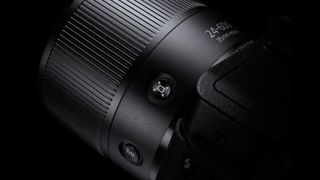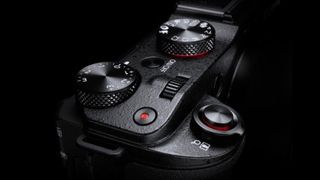Why you can trust TechRadar
The G3 X is a fairly rugged camera, and it's functional rather than beautiful. The body, in particular, feels very solid and well engineered; it has a rubberised, textured coating that's comfortable and secure to hold, and the same level of weather- and dust-proofing as Canon's mid-range DSLRs.
The lens is unashamedly plastic but, aside from a slightly disconcerting rattle when it's in its off/closed position, it feels well constructed and smooth to operate. The large focus ring is a bonus and, despite being obviously electronic rather than mechanical, it feels more responsive and accurate than many of this type.
Weighing in at 733g (25.8 oz) including battery and measuring 123 x 77 x 105mm (4.8 x 3 x 4.1 inches), this is a relatively chunky and heavy camera; however, when you consider its versatility and all the functionality included, then both weight and size seem reasonable.
Controls
My one gripe would be with the position of the shutter button and incorporated zoom lever. I found my index finger naturally wanted to sit further in towards the centre of the camera, which would require extending the front plate, above the grip, so the shutter button sits nearer to the lens. It's not a deal-breaker but, with my relatively long hands, I found having to crook my finger so steeply a little uncomfortable. That said, the shutter button is responsive and well engineered, and the zoom lever works smoothly.

The on/off and movie buttons on the top plate are easy to access, but well recessed enough to preclude accidental pressing. The top mode and exposure dials are nicely finished, with textured metal around the edge and a red trim, reminiscent of Canon's L-series DSLR lenses). These were a little too stiff in use for my liking, but better too stiff than too sensitive.
I also found the front scroll wheel, which typically is used to adjust the aperture or shutter speed, rather jerky to operate – perhaps because, as with the shutter button, I'd find it more accessible if it was positioned a little more towards the centre of the top plate.
There's a small pop-up flash on the top plate – it seems a little underpowered with its ranges of 6.8m (wide-angle) and 3.1m (telephoto), although for close-range work or in small rooms it does a good job of filling in shadows. The extra hole on the tripod mount on the base of the camera is evidence of Canon's desire to cater for videographers, with many video quick-release plates having a pin to lock the camera into place.
The focus ring on the lens also doubles as a multi-function ring, although it feels rather loose in operation; if, for example, you assign aperture settings to the ring, there's no click or semi-hard stop to indicate each change in f/ stop. You can clearly see the chosen aperture on the rear screen though, so it's not a huge issue and probably something you'd soon get used to.
In manual focus mode you have to revert to changing the aperture using the scroll wheel on the top plate. I found the focus ring a lot more comfortable for changing aperture than the scroll wheel, even if it is a little too easy to change it inadvertently.

On the side of the lens there's a manual focus and a framing assist/seek button. Again, it would be advantageous if the focus ring was a little firmer in use for manual focusing, but the fact that it's large and easy to operate does compensate for this. The framing assist button is designed to help you locate subjects when using the lens at its long end. It's a nice idea, but I found it a bit jerky and unpredictable at times, although this is something else that you're likely to become accustomed to after using the camera for a while.
The rear of the G3 X is largely taken up by the generously proportioned 3.2-inch touchscreen. While it would be nice to have a vari-angle screen, rather than one that simply tilts, there can be no complaints about its user-friendly touchscreen functionality, nor its superb 1,620,000-dot display, which is bright and detailed, and easy to see in most conditions.
The only issues I encountered with the screen were in bright sunlight, when I was shooting backlit scenes – at times I found it hard to compose shots accurately, particularly when using the lens at its longer end. Boosting the screen brightness for a few seconds by pressing the display button to the right of the screen helps, although you have to trust that you've got your settings correct, as your subject will look very overexposed.
I can't help feeling that an electronic viewfinder should have been built into the camera, although one can be purchased as an optional extra and fitted to the hotshoe; I can only assume that Canon decided not to include one in order to keep the price of the camera down, as fitting one wouldn't have had a significant impact on size and weight.
Aside from the difficulty in composing on the LCD at longer focal lengths, it's quite a challenge to keep a 600mm-equivalent lens steady when the camera is held away from your face. The five-axis image stabilisation works very well, and certainly helps in this regard, but it's still quite a challenge to frame a scene accurately when you're zoomed right in.
To the right of the screen is the typical style of control wheel that doubles as a four-way keypad and six partially recessed buttons, three of which are smaller and set back a little further because they're positioned close to where your right thumb will rest. All of these are easy to use, and don't seem prone to being accidentally pressed.
The control wheel is perhaps a little on the loose side, but it's easy to use. I found it frustrating that I couldn't use it to change some of the menu settings; to change the ISO setting, for example, you have to use the front dial, which feels counterintuitive. That said, most users are likely to be making the majority of their adjustments to settings via the excellent touchscreen as it's by far the quickest method – unless, perhaps, you're in cold conditions and wearing gloves.
Menu system
There's a quick menu button in the centre of the control wheel, but this brings up a relatively limited number of menu items and seems less useful than the quick menus on some competing cameras. The menu button the rear of the camera brings up the user-friendly menu system seen in Canon's DSLRs; it's quick and easy to navigate, particularly when using the touchscreen.
The items in the menus change according to what mode you're in; in many ways this makes sense, but it does cause inconvenience at times. I found it frustrating that I couldn't access some of the JPEG menu options (extending dynamic range, for example) unless I was in JPEG-only mode – with the camera set to raw plus JPEG shooting these items simply don't appear in the menu, and in the Quick Set menu they're greyed out.

Every camera is going to have a few quirks, and there are inevitable compromises between packing in the features and keeping everything accessible and easy to use. Overall, though, the G3 X is a super camera to use: it handles well and is fast and responsive in operation, despite the huge zoom range.
The Wi-Fi functionality is easy to set up, and Canon's free Camera Connect app works smoothly. As well as enabling you to review and upload pictures, the app also enables you to control the camera remotely, with access to all the key controls and settings. I found it hard to tell if I'd really achieved focus on my iPhone 5 screen, but the resulting pictures were correctly focused – and presumably, the better your phone screen, the better the picture you'll see.

